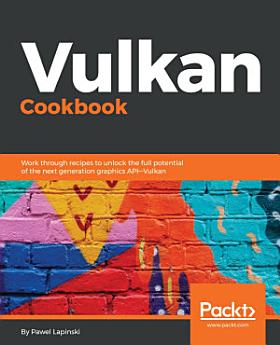Vulkan Cookbook: Work through recipes to unlock the full potential of the next generation graphics API—Vulkan
About this ebook
- This book explores a wide range of modern graphics programming techniques and GPU compute methods to make the best use of the Vulkan API
- Learn techniques that can be applied to a wide range of platforms desktop, smartphones, and embedded devices
- Get an idea on the graphics engine with multi-platform support and learn exciting imaging processing and post-processing techniques
- Work with Swapchain to present images on screen
- Create, submit, and synchronize operations processed by the hardware
- Create buffers and images, manage their memory, and upload data to them from CPU
- Explore descriptor sets and set up an interface between application and shaders
- Organize drawing operations into a set of render passes and subpasses
- Implement geometry projection and tessellation, texturing, lighting, and post-processing techniques
- Write shaders in GLSL and convert them into SPIR-V assemblies
This book is ideal for developers who know C/C++ languages, have some basic familiarity with graphics programming, and now want to take advantage of the new Vulkan API in the process of building next generation computer graphics. Some basic familiarity of Vulkan would be useful to follow the recipes. OpenGL developers who want to take advantage of the Vulkan API will also find this book useful.
Ratings and reviews
- Flag inappropriate
About the author
Pawel Lapinski is a graphics software engineer at Intel Corporation. His professional career started 10 years ago when he and his friends were hired to develop a 3D training/simulation application using C++, OpenGL, and Cg, which was later improved with added head-mounted display support and stereoscopic image generation. Since his studies, Pawel has been interested in 3D graphics and especially in the open multiplatform OpenGL library. He wrote a diploma about the Effective usage of vertex and fragment shaders. Since then, he has continued to pursue opportunities to work with 3D graphics and expand his knowledge in the field. He had the opportunity to join a team that was developing one of the biggest CAVE-like installations at the Polish Gdansk University of Technology. His responsibility was to prepare 3D visualizations using Unity3D engine and add stereoscopic image generation and support for motion tracking. Pawel's whole career has involved working with computer graphics, the OpenGL library, and shaders. However, some time ago, already as a programmer at Intel, he had the opportunity to start working with the Vulkan API when he prepared validation tests for the Vulkan graphics driver. He also prepared a series of tutorials teaching people how to use Vulkan and now he wants to share more of his knowledge in the form of a Vulkan Cookbook.




